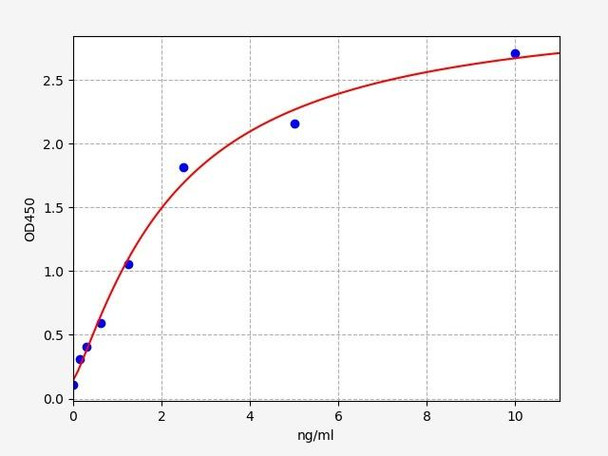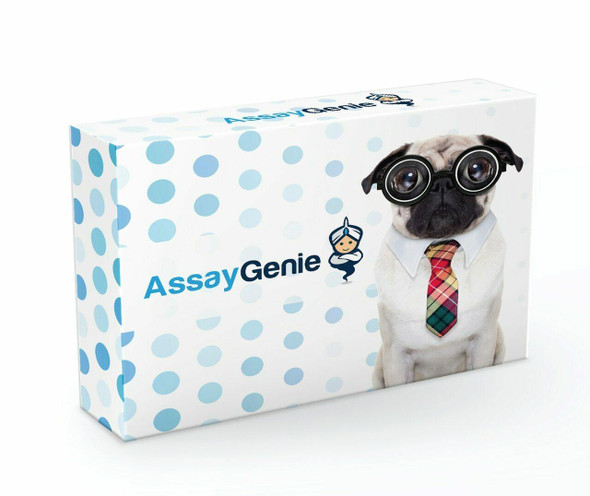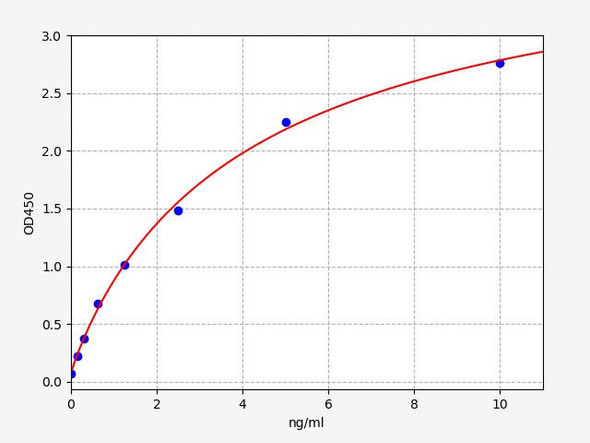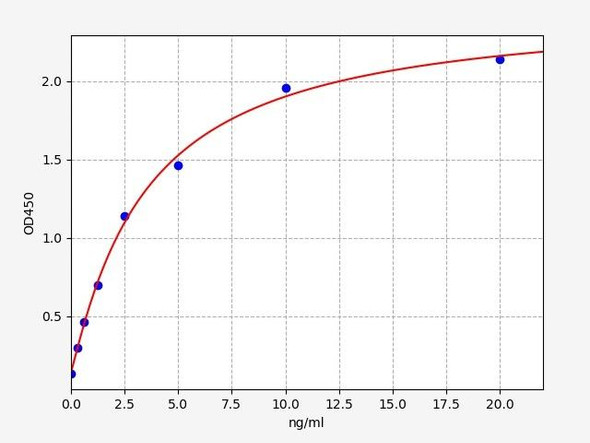Description
Human FADD (FAS-associated death domain protein) ELISA Kit (HUFI07929)
The Human FADD (Fas-associated death domain) Protein ELISA Kit is specifically designed for the accurate and precise measurement of FADD levels in human biological samples such as serum, plasma, and cell culture supernatants. This kit offers exceptional sensitivity and specificity, providing researchers with reliable and reproducible results for a variety of research applications.FADD is a key protein involved in the regulation of cell death pathways, particularly in the activation of apoptosis. Dysregulation of FADD has been implicated in various diseases, including cancer and autoimmune disorders, making it a valuable biomarker for understanding disease mechanisms and developing targeted therapies.
By utilizing the Human FADD Protein ELISA Kit, researchers can gain valuable insights into the role of FADD in disease pathology and potentially identify novel therapeutic targets for intervention. This kit is an essential tool for any laboratory conducting research in the fields of cell biology, immunology, and oncology.
| Product Name: | Human FADD (FAS-associated death domain protein) ELISA Kit |
| Product Code: | HUFI07929 |
| Size: | 96 Assays |
| Alias: | FADD ELISA Kit, GIG3 ELISA Kit, MORT1 ELISA Kit, Protein FADD ELISA Kit |
| Detection method: | Sandwich ELISA, Double Antibody |
| Application: | This immunoassay kit allows for the in vitro quantitative determination of Human FADD (FAS-associated death domain protein) concentrations in serum plasma and other biological fluids. |
| Sensitivity: | < 0.094ng/ml |
| Range: | 0.156-10ng/ml |
| Storage: | 4°C for 6 months |
| Note: | For Research Use Only |
| Recovery: | Matrices listed below were spiked with certain level of Human FADD (FAS-associated death domain protein) and the recovery rates were calculated by comparing the measured value to the expected amount of Human FADD (FAS-associated death domain protein) in samples. Enquire for more information. |
| Linearity: | The linearity of the kit was assayed by testing samples spiked with appropriate concentration of Human FADD (FAS-associated death domain protein) and their serial dilutions. The results were demonstrated by the percentage of calculated concentration to the expected. Enquire for more information. |
| CV(%): | Intra-Assay: CV<8% Inter-Assay: CV<10% |
| Component | Quantity | Storage |
| ELISA Microplate (Dismountable) | 8×12 strips | 4°C for 6 months |
| Lyophilized Standard | 2 | 4°C/-20°C |
| Sample/Standard Dilution Buffer | 20ml | 4°C |
| Biotin-labeled Antibody(Concentrated) | 120ul | 4°C (Protect from light) |
| Antibody Dilution Buffer | 10ml | 4°C |
| HRP-Streptavidin Conjugate(SABC) | 120ul | 4°C (Protect from light) |
| SABC Dilution Buffer | 10ml | 4°C |
| TMB Substrate | 10ml | 4°C (Protect from light) |
| Stop Solution | 10ml | 4°C |
| Wash Buffer(25X) | 30ml | 4°C |
| Plate Sealer | 5 | - |
Other materials and equipment required:
- Microplate reader with 450 nm wavelength filter
- Multichannel Pipette, Pipette, microcentrifuge tubes and disposable pipette tips
- Incubator
- Deionized or distilled water
- Absorbent paper
- Buffer resevoir
| UniProt Protein Function: | FADD: an adaptor molecule that mediates apoptosis. Recruited through its C-terminal death domain by Fas-receptor, tumor necrosis factor receptor, TNFRSF25, and TRAIL-receptor, participating in the death signaling initiated by these receptors. Interaction with the receptors unmasks the N-terminal effector domain of this protein, which recruits caspase-8, and thereby activates the cysteine protease cascade. Knockout studies in mice also suggest the importance of this protein in early T cell development. |
| UniProt Protein Details: | Protein type:Apoptosis; Adaptor/scaffold Chromosomal Location of Human Ortholog: 11q13.3 Cellular Component: neuron projection; CD95 death-inducing signaling complex; cytosol; lipid raft Molecular Function:identical protein binding; protein binding; protease binding; death receptor binding; protein complex binding; tumor necrosis factor receptor superfamily binding; tumor necrosis factor receptor binding Biological Process: viral reproduction; positive regulation of apoptosis; apoptosis; positive regulation of T cell mediated cytotoxicity; positive regulation of proteolysis; protein heterooligomerization; T cell differentiation in the thymus; toll-like receptor 3 signaling pathway; positive regulation of activated T cell proliferation; positive regulation of interleukin-8 production; T cell homeostasis; positive regulation of macrophage differentiation; toll-like receptor 4 signaling pathway; defense response to virus; positive regulation of adaptive immune response; spleen development; caspase activation; positive regulation of I-kappaB kinase/NF-kappaB cascade; thymus development; MyD88-independent toll-like receptor signaling pathway; positive regulation of tumor necrosis factor production; lymph node development; positive regulation of interferon-gamma production; induction of apoptosis via death domain receptors; toll-like receptor signaling pathway; innate immune response; positive regulation of transcription from RNA polymerase II promoter Disease: Infections, Recurrent, With Encephalopathy, Hepatic Dysfunction, And Cardiovascular Malformations |
| NCBI Summary: | The protein encoded by this gene is an adaptor molecule that interacts with various cell surface receptors and mediates cell apoptotic signals. Through its C-terminal death domain, this protein can be recruited by TNFRSF6/Fas-receptor, tumor necrosis factor receptor, TNFRSF25, and TNFSF10/TRAIL-receptor, and thus it participates in the death signaling initiated by these receptors. Interaction of this protein with the receptors unmasks the N-terminal effector domain of this protein, which allows it to recruit caspase-8, and thereby activate the cysteine protease cascade. Knockout studies in mice also suggest the importance of this protein in early T cell development. [provided by RefSeq, Jul 2008] |
| UniProt Code: | Q13158 |
| NCBI GenInfo Identifier: | 2498355 |
| NCBI Gene ID: | 8772 |
| NCBI Accession: | Q13158.1 |
| UniProt Secondary Accession: | Q13158,Q14866, Q6IBR4, |
| UniProt Related Accession: | Q13158 |
| Molecular Weight: | 208 |
| NCBI Full Name: | FAS-associated death domain protein |
| NCBI Synonym Full Names: | Fas (TNFRSF6)-associated via death domain |
| NCBI Official Symbol: | FADD |
| NCBI Official Synonym Symbols: | GIG3; MORT1 |
| NCBI Protein Information: | FAS-associated death domain protein; growth-inhibiting gene 3 protein; mediator of receptor induced toxicity; mediator of receptor-induced toxicity; Fas-associating protein with death domain; Fas-associating death domain-containing protein |
| UniProt Protein Name: | FAS-associated death domain protein |
| UniProt Synonym Protein Names: | FAS-associating death domain-containing protein; Growth-inhibiting gene 3 protein; Mediator of receptor induced toxicity; Protein FADD |
| Protein Family: | Fas-associated death domain protein |
| UniProt Gene Name: | FADD |
| UniProt Entry Name: | FADD_HUMAN |
*Note: Protocols are specific to each batch/lot. For the correct instructions please follow the protocol included in your kit.
Before adding to wells, equilibrate the SABC working solution and TMB substrate for at least 30 min at 37 °C. When diluting samples and reagents, they must be mixed completely and evenly. It is recommended to plot a standard curve for each test.
| Step | Protocol |
| 1. | Set standard, test sample and control (zero) wells on the pre-coated plate respectively, and then, record their positions. It is recommended to measure each standard and sample in duplicate. Wash plate 2 times before adding standard, sample and control (zero) wells! |
| 2. | Aliquot 0.1ml standard solutions into the standard wells. |
| 3. | Add 0.1 ml of Sample / Standard dilution buffer into the control (zero) well. |
| 4. | Add 0.1 ml of properly diluted sample ( Human serum, plasma, tissue homogenates and other biological fluids.) into test sample wells. |
| 5. | Seal the plate with a cover and incubate at 37 °C for 90 min. |
| 6. | Remove the cover and discard the plate content, clap the plate on the absorbent filter papers or other absorbent material. Do NOT let the wells completely dry at any time. Wash plate X2. |
| 7. | Add 0.1 ml of Biotin- detection antibody working solution into the above wells (standard, test sample & zero wells). Add the solution at the bottom of each well without touching the side wall. |
| 8. | Seal the plate with a cover and incubate at 37 °C for 60 min. |
| 9. | Remove the cover, and wash plate 3 times with Wash buffer. Let wash buffer rest in wells for 1 min between each wash. |
| 10. | Add 0.1 ml of SABC working solution into each well, cover the plate and incubate at 37 °C for 30 min. |
| 11. | Remove the cover and wash plate 5 times with Wash buffer, and each time let the wash buffer stay in the wells for 1-2 min. |
| 12. | Add 90 µL of TMB substrate into each well, cover the plate and incubate at 37 °C in dark within 10-20 min. (Note: This incubation time is for reference use only, the optimal time should be determined by end user.) And the shades of blue can be seen in the first 3-4 wells (with most concentrated standard solutions), the other wells show no obvious color. |
| 13. | Add 50 µL of Stop solution into each well and mix thoroughly. The color changes into yellow immediately. |
| 14. | Read the O.D. absorbance at 450 nm in a microplate reader immediately after adding the stop solution. |
When carrying out an ELISA assay it is important to prepare your samples in order to achieve the best possible results. Below we have a list of procedures for the preparation of samples for different sample types.
| Sample Type | Protocol |
| Serum | If using serum separator tubes, allow samples to clot for 30 minutes at room temperature. Centrifuge for 10 minutes at 1,000x g. Collect the serum fraction and assay promptly or aliquot and store the samples at -80°C. Avoid multiple freeze-thaw cycles. If serum separator tubes are not being used, allow samples to clot overnight at 2-8°C. Centrifuge for 10 minutes at 1,000x g. Remove serum and assay promptly or aliquot and store the samples at -80°C. Avoid multiple freeze-thaw cycles. |
| Plasma | Collect plasma using EDTA or heparin as an anticoagulant. Centrifuge samples at 4°C for 15 mins at 1000 × g within 30 mins of collection. Collect the plasma fraction and assay promptly or aliquot and store the samples at -80°C. Avoid multiple freeze-thaw cycles. Note: Over haemolysed samples are not suitable for use with this kit. |
| Urine & Cerebrospinal Fluid | Collect the urine (mid-stream) in a sterile container, centrifuge for 20 mins at 2000-3000 rpm. Remove supernatant and assay immediately. If any precipitation is detected, repeat the centrifugation step. A similar protocol can be used for cerebrospinal fluid. |
| Cell culture supernatant | Collect the cell culture media by pipette, followed by centrifugation at 4°C for 20 mins at 1500 rpm. Collect the clear supernatant and assay immediately. |
| Cell lysates | Solubilize cells in lysis buffer and allow to sit on ice for 30 minutes. Centrifuge tubes at 14,000 x g for 5 minutes to remove insoluble material. Aliquot the supernatant into a new tube and discard the remaining whole cell extract. Quantify total protein concentration using a total protein assay. Assay immediately or aliquot and store at ≤ -20 °C. |
| Tissue homogenates | The preparation of tissue homogenates will vary depending upon tissue type. Rinse tissue with 1X PBS to remove excess blood & homogenize in 20ml of 1X PBS (including protease inhibitors) and store overnight at ≤ -20°C. Two freeze-thaw cycles are required to break the cell membranes. To further disrupt the cell membranes you can sonicate the samples. Centrifuge homogenates for 5 mins at 5000xg. Remove the supernatant and assay immediately or aliquot and store at -20°C or -80°C. |
| Tissue lysates | Rinse tissue with PBS, cut into 1-2 mm pieces, and homogenize with a tissue homogenizer in PBS. Add an equal volume of RIPA buffer containing protease inhibitors and lyse tissues at room temperature for 30 minutes with gentle agitation. Centrifuge to remove debris. Quantify total protein concentration using a total protein assay. Assay immediately or aliquot and store at ≤ -20 °C. |
| Breast Milk | Collect milk samples and centrifuge at 10,000 x g for 60 min at 4°C. Aliquot the supernatant and assay. For long term use, store samples at -80°C. Minimize freeze/thaw cycles. |









